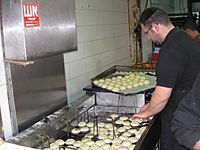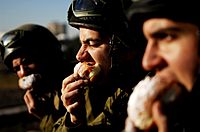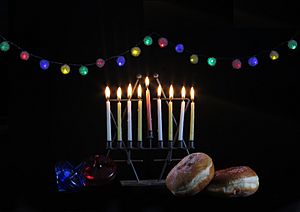Sufganiyah facts for kids
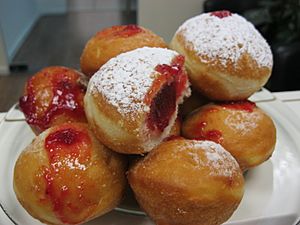
Classic Hanukkah sufganiyot
|
|
| Alternative names | Sufganiot |
|---|---|
| Type | Jelly doughnut |
| Place of origin | Central Europe |
| Main ingredients | Dough, jelly filling, powdered sugar |
A sufganiyah (plural: sufganiyot) is a round, puffy jelly doughnut. People in Israel and around the world eat them during the Jewish holiday of Hanukkah. These tasty treats are deep-fried in oil, often filled with jam or custard, and then sprinkled with powdered sugar.
The idea for this type of doughnut started in Europe in the 1500s. By the 1800s, it was known as a Berliner in Germany. Polish Jews made a similar doughnut called a ponchik. They fried it in schmaltz (chicken fat) instead of lard to follow kashrut laws, which are Jewish dietary rules. When Polish Jewish immigrants moved to Israel, they brought the ponchik recipe with them. There, it was renamed sufganiyah, a name inspired by a description of "spongy dough" found in ancient Jewish texts called the Talmud.
Contents
Why Eat Sufganiyot on Hanukkah?
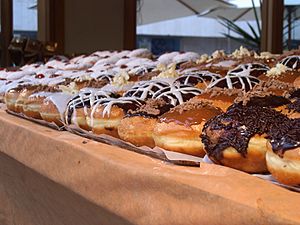
During Hanukkah, Jewish people have a special custom of eating fried foods. This tradition helps them remember a miracle that happened long ago. The miracle involved a small amount of oil that kept a lamp burning for eight days in the Temple in Jerusalem.
Eating deep-fried pastries on Hanukkah is a very old tradition. Even a wise rabbi named Maimonides, who lived in the 1100s, mentioned it. His father wrote that people should respect the custom of eating "fried fritters" on Hanukkah because it was a tradition from "the ancient ones." These early fried treats were probably sweet cakes soaked in syrup, similar to zalabiya found in the Arab world today.
What Does "Sufganiyah" Mean?
The word sufganiyah is a modern Hebrew word for a pastry. It comes from older words in the Talmud, sofgan and sfogga, which mean "spongy dough." The word is related to the modern Hebrew word for sponge, sfog, which comes from an Ancient Greek word meaning "sponge." Sfenj, a type of doughnut from Morocco, also shares the same root word.
There's a fun story that says sufganiyah comes from a Hebrew phrase meaning "the end of the Garden of the Lord" (referring to the Garden of Eden). The story says that after Adam and Eve left the Garden, the Lord cheered them up by giving them sufganiyot. However, this is just a folktale and not supported by ancient religious writings.
How Sufganiyot Came to Be
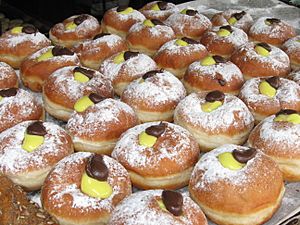
The first recipe for a filled jelly doughnut was written down in a cookbook in Germany in 1485. It described putting jam between two pieces of yeast dough and deep-frying them. This doughnut became popular across northern Europe in the 1500s. In 19th-century Germany, it became known as a Berliner or Bismarck.
Polish Jews made their version, called ponchkis. They used oil or schmaltz for frying instead of lard, to follow their dietary laws. When Polish Jewish immigrants moved to Palestine (which is now Israel), they brought this recipe and the tradition of eating them on Hanukkah. In Palestine, these doughnuts got their new name, sufganiyot, because they were like the "spongy dough" mentioned in the Talmud.
What Are Sufganiyot Like Today?
Originally, ponchik-style sufganiyot were made by putting jelly between two dough circles, sticking them together, and then frying them. Today, it's often easier to deep-fry whole balls of dough and then inject the filling using a special tool.
Most sufganiyot in Israel are made from sweet yeast dough. They are usually filled with plain red jelly, like strawberry or raspberry, and topped with powdered sugar. Some bakeries offer more fancy versions with fillings like dulce de leche, chocolate cream, vanilla cream, or halva. These might have special toppings like coconut or fruit pastes.
Mini Sufganiyot
In 2016, Israeli bakeries started making smaller sufganiyot. This was partly because the Health Minister encouraged people to eat less junk food. A regular sufganiyah can have 400 to 600 calories. The new "mini" versions are about half the size and have different fillings and toppings.
How Popular Are Sufganiyot?
In Israel
For a long time, sufganiyot and latkes (potato pancakes) were equally popular Hanukkah foods in Israel. But in the 1920s, a labor union in Israel wanted to create more jobs for its members. They encouraged bakeries to sell sufganiyot earlier and for longer periods before Hanukkah. This helped sufganiyot become the most popular Hanukkah food in Israel. Today, more Israelis eat sufganiyot on Hanukkah than fast on Yom Kippur, a different Jewish holiday.
Israeli bakeries start selling sufganiyot as early as September. Angel Bakeries, one of the biggest bakeries in Israel, fries over 25,000 sufganiyot every day during the eight-day Hanukkah festival. The Israeli Ministry of Defense even buys more than 400,000 sufganiyot for its soldiers each Hanukkah! Most soldiers prefer jelly-filled ones.
In Other Jewish Communities
Sufganiyot are a newer tradition in the United States. For a long time, latkes were the main Hanukkah food there. However, American Jews who visited or studied in Israel, and Israeli Jews who moved to the U.S., helped make sufganiyot more popular.
Before the 1970s, sufganiyot were not widely sold in the United States. But now, many bakeries in Jewish communities sell them. Even big doughnut chains like Dunkin' Donuts and Krispy Kreme offer sufganiyot in their kosher-certified stores. Jewish communities in places like Russia and Ukraine also organize special "community bakes" to make sufganiyot for parties.
Savory Sufganiyot
While most sufganiyot are sweet, some savory (not sweet) versions exist. In 2018, some restaurants in Manhattan started making sufganiyot filled with things like chicken schnitzel or pastrami. Other savory types include:
- Panzerotti in Italy, which are filled with mozzarella cheese and tomato sauce.
- Lachmazikas in Spain, filled with various ingredients like lamb, mushrooms, or fish.
- Sambusa-inspired savory sufganiyot, filled with lentils and peas, are popular among Iraqi Jews in Israel.
Images for kids
-
Sufganiyot from a bakery in Jerusalem
See also
 In Spanish: Sufganiá para niños
In Spanish: Sufganiá para niños


